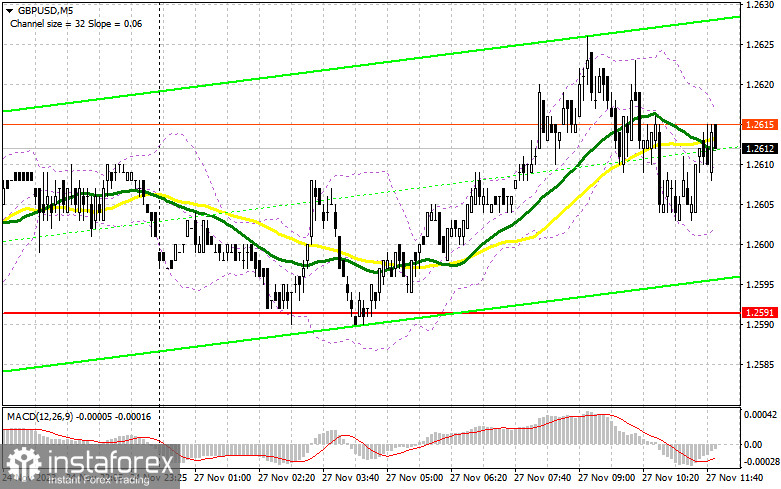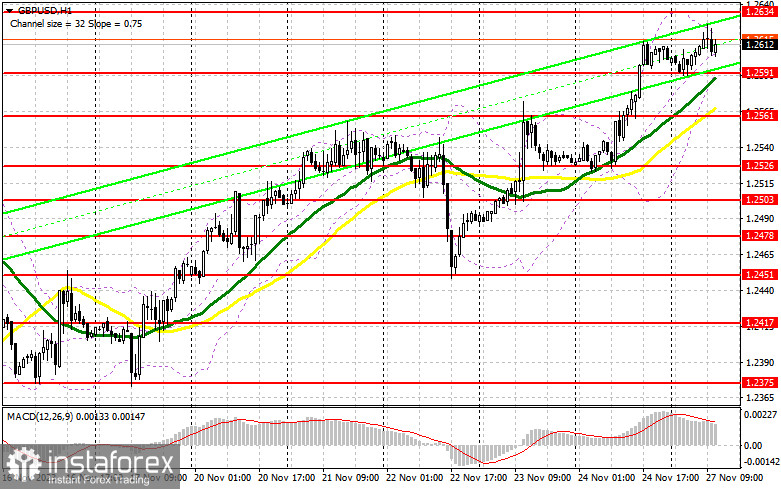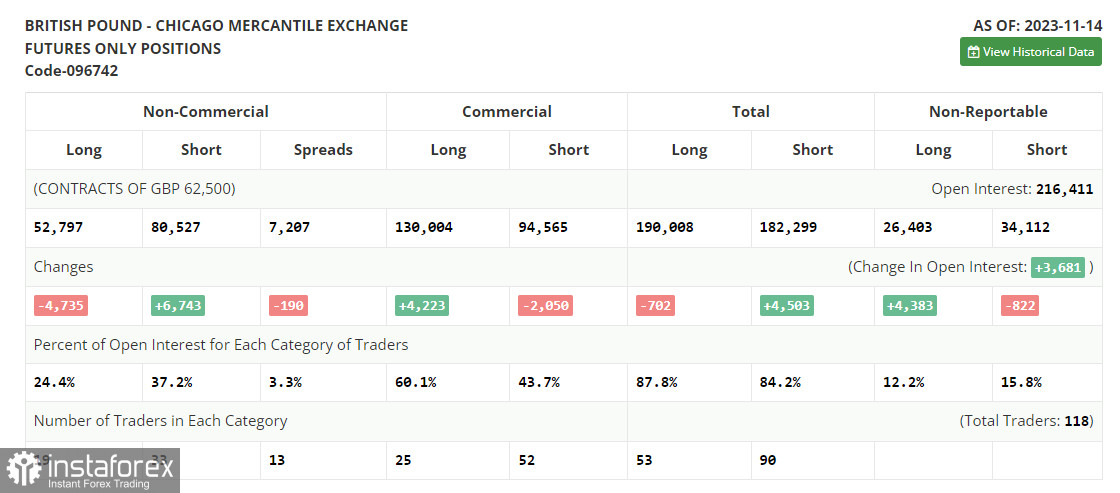In my morning forecast, I drew attention to the level of 1.2591 and recommended making entry decisions based on it. Let's look at the 5-minute chart and analyze what happened. The decline towards 1.2591 occurred, but testing and forming a false breakout was not achieved due to low volatility. For this reason, the technical picture has not been reassessed for the second half of the day.

To open long positions on GBP/USD, it is required:
The released statistics on retail sales from the Confederation of British Industry went unnoticed by traders, and after an unremarkable attempt to consolidate at a new local maximum, pressure on the pair returned without significantly affecting the overall technical picture. Ahead of us is data on the volume of home sales in the primary market in the United States, which must lead to a surge in volatility, without which we will not be able to receive entry signals into the market today. Strong data on real estate sales in the US and a decline in the pair will lead to a test of support at 1.2591, where the formation of a false breakout will provide an entry point for long positions to develop the uptrend further and update the resistance at 1.2634, which we also did not reach in the first half of the day. A breakthrough and consolidation above this range will lead to a new signal to open long positions with an exit to 1.2670. The ultimate target will be the area of 1.2709, where I will take profit. In the scenario of a pair's decline and the absence of buyer activity at 1.2591 in the second half of the day, pressure on the pair will increase, leading to a more significant downward correction. In this case, only a false breakout in the area of the next support at 1.2561, where the moving averages intersect, will give a signal to open long positions. I plan to buy GBP/USD immediately on a rebound only from 1.2526 with the aim of a correction within the day by 30-35 points.
To open short positions on GBP/USD, it is required:
Talking about the fact that sellers have started to act in the market can only happen after bears take the level of 1.2591. With it, the technical picture is likely to change significantly. Poor US statistics in the second half of the day will only add to the problems for the already weak US dollar, so all attention continues to focus on the level of 1.2634, the defense of which is necessary just as much as the breakout of 1.2591. Only forming a false breakout there will allow a downward movement to the support of 1.2591. A breakthrough and a reverse test from the bottom to the top of this range will deal a more serious blow to buyers' positions, removing stop orders and opening the way to 1.2561, where the moving averages, playing on the side of buyers, pass. A more distant target will be the area of 1.2526, where I will take profit. The uptrend will continue in the case of an upward movement of GBP/USD and the absence of activity at 1.2634 in the second half of the day. In this case, I will postpone sales until a false breakout at 1.2670. If there is no downward movement, I will sell GBP/USD immediately on a rebound from 1.2709, but only in anticipation of a pair correction down by 30-35 points within the day.


Indicator Signals:
Moving Averages:
Trading is slightly above the 30 and 50-day moving averages, indicating further pair growth.
Note: The author considers the period and prices of moving averages on the hourly chart H1 and differs from the general definition of classical daily moving averages on the daily chart D1.
Bollinger Bands:
In case of a decrease, the lower boundary of the indicator will act as support around 1.2591.
Indicator Descriptions:
- Moving Average (determines the current trend by smoothing volatility and noise). Period 50. Marked on the chart in yellow.
- Moving Average (determines the current trend by smoothing volatility and noise). Period 30. Marked on the chart in green.
- MACD indicator (Moving Average Convergence/Divergence — convergence/divergence of moving averages) Fast EMA period 12. Slow EMA period 26. SMA period 9.
- Bollinger Bands. Period 20.
- Non-commercial traders - speculators, such as individual traders, hedge funds, and large institutions, use the futures market for speculative purposes and meet certain requirements.
- Long non-commercial positions represent the total long open position of non-commercial traders.
- Short non-commercial positions represent the total short open positions of non-commercial traders.
- The total non-commercial net position is the difference between non-commercial traders' short and long positions.
 English
English 
 Русский
Русский Bahasa Indonesia
Bahasa Indonesia Bahasa Malay
Bahasa Malay ไทย
ไทย Español
Español Deutsch
Deutsch Български
Български Français
Français Tiếng Việt
Tiếng Việt 中文
中文 বাংলা
বাংলা हिन्दी
हिन्दी Čeština
Čeština Українська
Українська Română
Română

